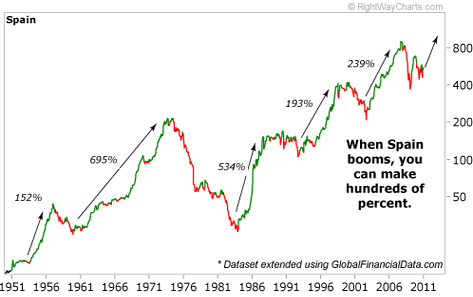| Home | About Us | Resources | Archive | Free Reports | Market Window |
Triple-Digit Upside Potential in an Unloved CountryBy
Wednesday, April 6, 2011
Who in their right mind would invest in Spain today?
If you've been paying attention lately, you know Spain is in bad shape...
It's one of Europe's heavily-indebted "PIIGS" countries. (The PIIGS are Portugal, Italy, Ireland, Greece, and Spain.) Unemployment is off-the-charts high. And Spain is in the midst of a housing bust.
Sounds bad. But the thing is, Spain is getting "less bad."
Investors have become fearful of the other PIIGS, pushing interest rates up to 8% and higher in Portugal, Ireland, and Greece. (They're over 12% in Greece.) But investors are feeling better about Spain, where interest rates are around 5%. Spain is getting less bad.
Longtime readers know I call this The Secret to 1,000% Gains: You want to buy when things go from Bad to Less Bad.
The thing is, Spain booms, and Spain busts. It does both spectacularly in its stock market. If you can catch one of those booms, you can make hundreds of percent gains in just a few years.
This chart below, from True Wealth Systems, shows Spain's booms and busts. (Green means we're in the trade, red means we're out. Right now, we're in.)
 Our True Wealth Systems computers tell us we could be at the start of another huge move... It's certainly possible, because Spanish stocks are CHEAP.
The chart here tells the story. Spanish stocks are coming off their lowest-ever valuations based on price-to-earnings ratios...
 In 1984, Spanish stocks were cheap, and they soared more than 500%. The next time Spanish stocks got even close to that cheap was 1990... and they boomed 193%.
After peaking in 2008, Spain has busted badly. And unlike the U.S. economy, which has recovered from the worst of it, Spain has struggled. But Spain's stock market – a good leading indicator of the economy – started rising early this year. A new uptrend is in place.
Longtime readers know I look for three things in an investment: 1) cheap, 2) hated, and 3) at the start of an uptrend.
Spain is the cheapest it's been since it soared 500%-plus, starting in 1984. Everyone has written Spain off... And yet the uptrend is in place.
Spain itself has a history of massive stock market booms and busts. Many of those booms were good for hundreds of percent gains. And our True Wealth Systems indicator flashed BUY a couple months ago.
The most reliable data for Spain starts in the 1950s. In every decade since, we had multiyear uptrends in Spain that led to triple-digit gains. Right now could be the start of this decade's triple-digit gain in Spain.
The easiest way to invest in Spain is through the iShares MSCI Spain Index Fund (EWP). Check it out...
Good investing,
Steve
Further Reading:
Steve's True Wealth Systems computers are producing big winners so far. And DailyWealth subscribers have access to some of his best calls.
If you had bought this Japanese fund last month, you could have made more than 5% in less than a week. Coal is up 50%. And energy stocks are on a monster tear.
Market NotesA NEW WAY FOR YOU TO VIEW COMMODITIES Over the past year or so, one of the biggest stories in all of finance is the soaring price of basic commodities like cotton, crude oil, coffee, corn, and soybeans. Many of these raw materials have soared 33%-50% in price since last summer.
But make sure to keep in mind that there are always two sides to a "price." There's the service, asset, or product we measure on one side, and there's the "measuring unit" on the other. The seasoned investor always keeps this in mind when sizing up opportunities and risks.
In the case of commodities, remember they are priced in dollars. As many DailyWealth readers know, the dollar is a huge, grinding, long-term bear market... which causes our colleague Porter Stansberry to say we aren't "facing" a dollar crisis, we are "in one right now."
The dollar's weakness is causing a major distortion to one side of the commodity price equation. Sure... oil and food are soaring when you measure them in dollars, but what if you measure them in "real money," aka gold? Today's chart gives you the answer...
Our chart displays the benchmark commodity index measured in gold terms over the past 18 months. As you can see, commodities have actually decreased in price when measured in gold. The "raw materials rising" story is more of a "dollar falling" story. The trend of "real money" outperforming "paper money" continues...
|
In The Daily Crux
Recent Articles
|

